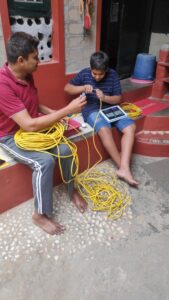Being truly connected with your child is one of the most powerful ways to help them feel safe and confident in facing life. But what does connection actually look like? A real connection with your child starts with active listening.
As parents, we often feel we know our child inside and out—after all, we’ve known them since birth. But think about it: can we truly say we completely understand any person in our life? Don’t we often misread or misunderstand even our closest ones?
It’s the same with children. They’re constantly changing and growing. Unless we’re paying close attention, it’s easy to miss what’s going on inside them.
Why Curiosity Matters More Than Certainty
That’s why staying curious—rather than making assumptions—is so important. True connection begins when we stop “knowing” and start listening.
So, how do we keep that connection alive?

The Key Is Listening—Not Just Hearing
One key skill is listening—and not just hearing their words, but really understanding what they are trying to say. Most of us tend to listen with our own interpretations running in the background. But real listening means being fully present, without judgment or rush.
“Listening is a magnetic and strange thing, a creative force… When we are listened to, it creates us, makes us unfold and expand.”
— Karl A. Menninger
Reflecting on Our Own Childhood
Think back to your growing-up years. Was there someone in your life who had a lasting impact on you? Someone whose presence felt safe, nurturing, and grounding?
For me, it wasn’t just one person—it was my mother, a kind uncle, and a few friends. What made them special wasn’t that they had all the answers. It was that they listened. They didn’t dismiss my stories, even when they seemed silly. They gave me space to speak, and in doing so, they helped me feel seen, heard, and valued.
That kind of listening builds trust. It helps us feel safe to simply be who we are.
“You cannot truly listen to anyone and do anything else at the same time.”
— M. Scott Peck
How Often Do We Truly Listen to Our Children?
Do we give the kind of listening that our children need? Haven’t there been many times that we have tuned out when they’re sharing something that doesn’t seem important to us or we are busy with something else?
Next time your child comes to share something—even if it feels small or trivial—try giving your full attention. Watch their eyes light up. Notice their expressions, the shifts in their tone, the feelings behind their words. Ask open-ended questions and stay curious about their world.
This kind of presence tells your child:
“You matter. What you feel and think matters.”
And that is one of the most powerful gifts we can give.
Example: Reflective Listening in Everyday Moments
Let’s explore how reflective listening can look in a typical situation.
A Common Conversation (Without Deep Listening)
A child walks in and says:
“Mumma, I don’t feel like doing my homework.”
The parent responds:
“Hmm… but you have to. Otherwise the teacher will give a red mark and complain during PTM.”
The child pleads:
“I know, but I don’t want to. Can you write a letter saying we were busy?”
The parent shuts it down:
“No, that would be lying. Stop avoiding it and just finish it.”
Now, Let’s Try Listening Differently
Child:
“Mumma, I don’t feel like doing my homework.”
Parent:
“Hmm… What do you feel like doing instead?”
Child:
“I want to go play with A.”
Parent:
“When do you think you’ll finish your homework then?”
Child:
“I really don’t feel like it.”
Parent:
“Any particular reason?”
Child:
“It’s that Probability Theory again—I hate it.”
Parent:
“What don’t you like about it?”
Child:
“I don’t know, I just do.”
Parent:
“Okay… but when you come back, let’s sit together and try to figure it out?”
Child:
“Okay, okay… I’ll be back in two hours!”
Parent:
“Alright. Have fun!”
Another Variation: Honoring the Child’s Feelings
Child:
“I don’t want to do today’s homework.”
Parent:
“Then?”
Child:
“I just want to do nothing.”
Parent:
“Nothing?”
Child:
“Maybe watch something.”
Parent:
“So that’s not really nothing, right?”
Child:
“Yeah… maybe not.”
Parent:
“What homework do you have today?”
Child:
“Math, English, Hindi.”
Parent:
“Is it all due tomorrow?”
Child:
“Yes.”
Parent:
“What will you tell your teacher if it’s not done?”
Child:
“I don’t know…”
Let the Conversation Flow
These conversations can go in many directions—if we stay present and let go of our urge to “fix” things. It’s hard sometimes. As parents, we have our own long to-do lists and stress. It’s tempting to just say, “Get it done!” and move on.
But the small effort of being with your child, listening without judgment, and staying curious about what’s going on inside them can go a long way in building trust, confidence, and lifelong connection.
Real-Life Inspiration
Check this video. An example of how patent’s being with the child matters. It’s not about giving in to every wish—it’s about being there, understanding, and walking with our children as they figure things out.